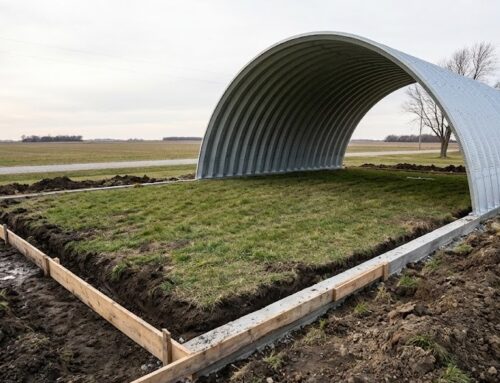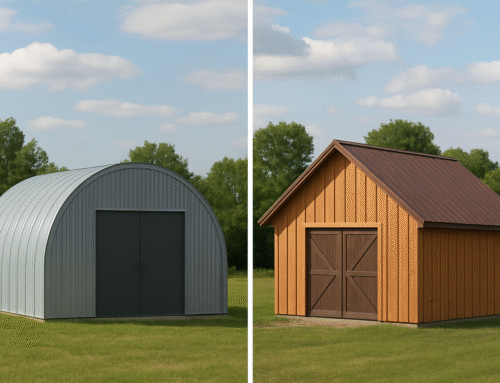
Anyone who’s ever put up a wood-frame structure can attest to the gradual degradation over time and the ongoing effort it takes to keep it from falling apart. Steel arch buildings, on the other hand, are different. One of the major reasons agricultural professionals, hobbyists, and rural landowners are turning to steel arch buildings is the dramatically reduced need for ongoing upkeep. While wooden structures demand constant attention with painting, sealing, replacing boards, and fighting rot, steel structures maintain their integrity with minimal intervention. In this blog, we’ll offer an actionable guide to maintaining your steel arch building, showing how easy it is to keep your investment in top shape year after year.
Why Maintenance Matters, Even When It’s Minimal
Unlike wood-frame buildings that often demand painting, patching, pest control, and roof repairs, steel structures are engineered for minimal intervention. Thanks to features like galvanized steel panels, rust resistance, and a clear-span design that reduces structural stress points, your maintenance to-do list is shorter from the start.
Here’s how to keep your building performing like new:
1. Routine Cleaning and Inspection (Quarterly)
AgriBilt buildings don’t need much, but a quarterly visual inspection will help you catch small issues before they become big.
Here’s your simple quarterly checklist:
- Drainage Check: Walk around the perimeter and confirm that water isn’t pooling near the base. Check for erosion or standing water.
- Fastener Check: Look for any loose or missing bolts or screws. Tighten where needed.
- Doors and Openings: Open and close doors to ensure smooth operation. Lubricate hinges or tracks if necessary.
- Surface Cleaning: Dust or debris on the exterior can be easily rinsed off with a garden hose or pressure washer on a low setting.
2. Drainage and Water Management
AgriBilt’s curved arch design naturally sheds water and snow, making ponding and roof buildup a non-issue. However, water pooling around the base of the building can still lead to long-term concerns if not addressed.
To maintain proper drainage:
- Ensure Proper Site Grading: The area around your building should slope gently away to encourage runoff.
- Clear Gutter Systems (if installed): Although gutters are optional on steel arch buildings, if you’ve added them, clean out leaves or sediment as part of your quarterly inspection.
- Watch for Soft Spots or Washouts: If the soil near your foundation is washing away, adding gravel or compacted fill can help redirect water.
3. Hardware and Fastener Care
Because steel naturally expands and contracts with temperature fluctuations (known as thermal movement), it’s good practice to check bolts and screws periodically.
Focus areas include:
- Endwalls: These tend to experience the most vibration and wind stress.
- Door Frames and Attachments: Hardware here may loosen slightly over time due to regular use.
- Base Connectors: Retighten or replace any hardware that appears worn or corroded.
4. Galvanized Coating Protection
All AgriBilt buildings are constructed from galvanized steel, a protective coating that guards against rust and corrosion. This coating is what sets AgriBilt apart from many other steel structures on the market, especially those using untreated or painted steel.
Here’s how to maintain this protection:
- Inspect for Scratches or Scuffs: Minor dings can be touched up with a zinc-rich cold galvanizing compound available at most hardware stores.
- Watch for Discoloration: Rare, but early signs of corrosion may appear near fasteners or at ground contact if water accumulates.
- Avoid Harsh Chemicals: When cleaning, skip bleach or acidic cleaners—mild soap and water are plenty.
5. Seasonal Maintenance Schedule
Spring Prep: Post-Winter Inspection
- Check for any snow or ice damage, particularly near the base.
- Lubricate hinges, clean surfaces, and ensure vents and doors are clear for warm-weather use.
Fall Winterization:
- Clear nearby leaves or debris to keep drainage paths open.
- Make sure your structure is sealed tight to keep out snow or rodents.
- If using the building for livestock or equipment storage, double-check climate control features or insulation (if applicable).
Annual Deep Clean:
Once a year—typically in late spring or early summer—is a great time for a more thorough maintenance session:
- Wash down the full exterior.
- Recheck all fasteners.
- Perform a roofline inspection from ground level (binoculars work well).
- Touch up any minor cosmetic flaws.
How AgriBilt Compares
Steel arch buildings, in general, offer lower maintenance than wood, but not all steel structures are created equal.
Here’s how AgriBilt stands out:
- Galvanized Steel Protection: Not all competitors offer true galvanized protection, which significantly reduces rust risk.
- Clear-Span Design: Fewer internal supports mean less structural stress and fewer failure points.
- No Paint, No Rot, No Pests: Unlike wood, you’ll never need to repaint, replace rotted posts, or spray for termites.
- No Special Tools Required: Maintenance is DIY-friendly from day one, with no specialty equipment needed for setup or upkeep.
Easy Upkeep, Long-Term Value
Steel arch buildings were designed to simplify life for farmers, landowners, and professionals who don’t have time for endless repairs. With an AgriBilt structure, you’re investing in durability, simplicity, and peace of mind.
Whether you’re housing equipment, livestock, grain, or tools, the last thing you want is another maintenance burden. With just a few short inspections a year that require very minimal effort, your AgriBilt building will stand strong for decades.
Considering a new steel arch building? Contact AgriBilt today to learn more about our models, pricing, and clearance offers available by phone only.



